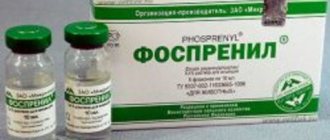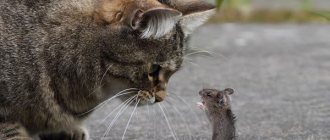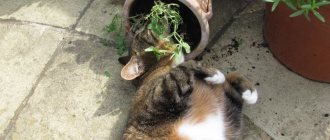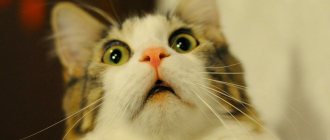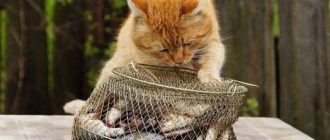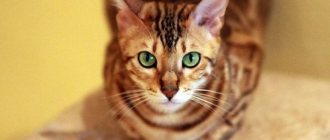A cat is essentially a predator, but already so domesticated that humans have to take care of its well-being. The first priority is nutrition. A balanced diet plays a major role in the length and quality of life of a pet.
One of the controversial issues is whether cats can be given chicken bones. Veterinarians agree that such a delicacy should be abandoned. Some experienced cat owners do not see any threat in chicken bones, and confirm the harmlessness of this kind of treat with their own experience - they cite their healthy pets as an example. Why such different opinions? Let's figure it out now.
What's the best way to give?
It is not advisable to treat your pet to boiled parts of a bird's skeleton.
If, nevertheless, the owner prefers to feed the cat chicken breast or other bones, then it is worth knowing how to feed the animal with them correctly in order to reduce the risks of deviations and negative consequences. When feeding such products, adhere to the following recommendations:
- Completely exclude tubular bones from the cat’s diet, which, when the pet eats, break into sharp fragments that injure the mucous membranes.
- It is forbidden to feed boiled chicken, which becomes even harder. Due to heat treatment, bones are less digestible.
- Chicken skin, bone structures, legs and necks should be hammered or processed into minced meat before serving. In this case, it is necessary to remove hard parts such as beaks and others.
- For adult felines, it is necessary to feed no more than 5-10% of bones from the total diet. If there is a lot of such food, then there is a high probability of constipation or intestinal obstruction.
- Kittens and older animals should not consume such products, since their jaws are weaker and cannot always bite through hard pieces.
Video about feeding a cat bones
Chicken meat, bones and offal are extremely beneficial for cats, but feeding them to pets has its own characteristics. Some chicken bones are potentially dangerous and have their own characteristics in preparation before feeding them to a mustachioed household member. Is it possible to give chicken necks to a cat? This is a question that arises among owners who want to enrich their pet’s diet with natural products as much as possible without harming it.
Cats are carnivores that need a complete diet, which necessarily includes meat and bone products. The protein contained in chicken by-products should make up at least 30-40% of the total diet of adult cats. Before giving your pet chicken bones, you need to familiarize yourself with all the dangers and features of serving this product.
All chicken bones contain useful substances necessary for the cat’s body. Chicken necks and heads are considered the most valuable due to the presence of brain in them. Brain and spinal cord is a very useful and nutritious product for cats, since in its fresh form it contains many phospholipids, calcium, trace elements, vitamins and minerals. Chicken necks should be included regularly in a cat’s diet, as an addition to the main food. Eating fresh and natural chicken bones helps improve the skin, coat and other tissues of your four-legged friend, which undoubtedly improves the condition and appearance of your pet.
Chicken necks contain
:
- Vitamins - PP, E, B (12, 5, 6, 9, 2, 1), A;
- Minerals: (Se, Mn, Cu, Zn, Fe, P, K, Na, Mg, Ca);
- Proteins;
- Fats;
- Carbohydrates;
- Unsaturated fatty acids.
Although nutritious and healthy, some chicken bones are dangerous, and eating them by cats can cause serious health problems. The structure of the chicken skeleton implies the presence of tubular bones (feet and wings) which are very dangerous for the health and even the life of the animal. Sharp fragments of tubular bones can lead to perforation of the walls of the cat’s digestive tract. It is also dangerous to feed your pet boiled bone mass, due to possible blockage of the stomach or intestines.
Can I feed it chicken?
This is what we are guided by when we feed our pet such products. However, we forget that the meat we buy on store shelves is not as healthy as what an animal eats living on the street. So what to do? Go hunting? Not at all! It’s enough to just figure out which meat will be useful for a cat and which not so much.
- Chicken is harmful to cats, as it is most often stuffed with antibiotics and various growth hormones, and is also. It will have to be abandoned. Chicken skin won't do him any good either.
- Turkey is an excellent substitute for chicken meat, and it contains many times more vitamins and healthy ingredients.
- Pork is a very “heavy” food product not only for humans, but also for cats, which can cause stomach upset and indigestion. It also leads to the pet becoming infected with worms, and in some cases, other dangerous infectious diseases.
Attention!
Pork contains a large amount of fats that are harmful to the pet’s body.
Beef is a great alternative to pork
Even veterinarians recommend giving cats this treat. In some cases, you can diversify a cat's diet with rabbit meat, but this should be done rarely and with caution. Let rabbit meat be a kind of delicacy for the cat.
The most important thing when choosing a food product:
- Freshness.
Under no circumstances should you give your pet spoiled food. The meat must be fresh and of high quality. - Temperature.
It is not recommended to eat meat only from the refrigerator, much less from the freezer, but you also don’t have to reheat it, because hot food is also not allowed. It is enough to let it sit for a while at room temperature. - Fat content.
As already mentioned, cats don’t need excess fat. When serving meat to a cat, you need to get rid of the veins and fat. - You need to choose only clean meat, without tendons and bones.
Give preference to sirloin parts. Don’t forget to include by-products in your pet’s diet: liver, kidneys, heart. This should be done rarely and in small quantities.
Why is it better without chicken?
Important!
Veterinarians have long argued that chicken meat is harmful to cats.
Chicken, raw and cooked, has a harmful effect on the liver of animals.
Frequent use of it can cause irreversible changes in the organ and develop some diseases, in particular pancreatitis and urolithiasis.
In addition, chicken bones, when they fall apart, have very sharp pieces and pose a risk of mechanical damage to your pet.
If your cat “can’t live” without chicken, then give her a small amount of natural poultry, or rather, its loin.
What about fish with bones?
Fish in any form is not recommended to be included in the diet of cats. It is strictly contraindicated for castrated and sterilized cats, as it can cause the development of genitourinary diseases. Based on this, we can conclude that there is no need to give fish with bones to fluffies.
Green light for the chicken!
So, chicken can be given to kittens and adult cats almost every day, but not fried, but boiled and definitely WITHOUT bones, especially if it is a small kitten. At 3.5 months, when the baby has grown enough and his teeth have become stronger, you can start feeding him with chicken legs, and by one year - with chicken heads. But it is better to take the heads of young hens or chicks, they are more tender, their bones are soft, and it is convenient for cats to chew them. It is better to boil both the legs and heads thoroughly so that they become soft. Of course, cats need to be given raw meat sometimes, but not chicken because there is a risk of salmonella infection.
It is best to feed kittens chicken breast - soft meat and without bones. You can give boiled chicken by-products - heart, lungs, kidneys, liver. It should be noted that cats adore liver almost as much as fish, only experts and veterinarians do not advise getting carried away with it (they recommend no more than once a week), because the liver, as is known, is the body’s filter, including in animals, and therefore the coat may become coarser, and in light-haired pets the color may darken. Adult cats and small kittens don’t really like lungs and kidneys; they don’t really eat them. The heart is given 1-3 times a week.
A good option is to grind boiled chicken through a meat grinder and make a kind of minced chicken that can be given to kittens along with broth. This will make it more convenient and easier for the kitten to eat.
Why can't a cat eat bones?
Sometimes fragments of such food can get stuck between the animal's teeth.
If a cat ate chicken paws or other bones once, then perhaps nothing bad will happen, but when an animal constantly eats broken chicken bones, serious health problems are possible. The seed does not have any nutritional value, but contains many useful microelements. This is the only benefit to feeding your cat chicken bones. In most cases, such a component in a cat’s diet can have dangerous consequences, even if the bones are boiled or made into bone mince. Such nutrition threatens the following disorders:
- mechanical damage to the mucous membrane of the mouth, esophagus, stomach or intestines;
- hard pieces getting stuck between the teeth, which leads to gum injury;
- blockage of the digestive tract.
Tubular bones and chicken feet pose a particular danger to a cat's health. This is due to the fact that such parts have sharp edges that severely injure the mucous membrane. Spongy components are less dangerous, but can still provoke an inflammatory reaction or blockage of the esophagus. In the latter case, the cat exhibits the following unpleasant symptoms:
- constipation or diarrhea with blood in the stool;
- lethargic state;
- problems with appetite;
- repeated vomiting;
- copious amounts of saliva;
- pain during bowel movements.
Benefits and harms
Like any offal containing bones, the heads are rich in calcium and phosphorus, which is why breeders especially love them: cheap chicken heads satisfy the increased calcium needs of pregnant and lactating cats, as well as growing kittens. A large amount of collagen contributes to the proper development of joints in young animals, which is why chicken heads are also given to kittens.
In addition, cats chew their heads with great pleasure, which helps strengthen the dental system, keeps gums and teeth healthy, and prevents the formation of tartar.
We invite you to read: TOP 10 most dangerous killer fish in the world! Photo and description || The most dangerous fish on the planet ranking
However, although everything sounds tempting, there are also disadvantages to feeding chicken heads. We have already discussed the dangers posed by bones and by-products containing them in the article “Can I give my cat chicken bones?” This means: if a cat eats chicken heads, he is not immune from serious problems with the gastrointestinal tract, and complications can arise at any time.
Meat intolerance
Meat treats for cats are quite weighty and tempting products that are 90% digestible. Most owners stop feeding their cats raw meat due to poor tolerance. The animal may experience an upset stomach or an urge to eat. This does not mean at all that it is a dangerous and incompatible food product for cats. Here we should focus on the potential capabilities of the digestive tract, the stomach, where hard or lumpy food is digested. Typically, in such situations, cats may have a reduced level of acidity of digestive juice, and an inflammatory disease of the stomach may develop.
The stomach stops coping with certain loads. The digestive organ can no longer cope with raw meat even if you constantly give the animal boiled food and ready-made food. require a different process for implementing the functions of the digestive glands, pancreas and gastrointestinal mucosa.
Boiled chicken bones won't do any good for cats.
, they are poorly digested and can cause. You can introduce small amounts of cartilage into your diet. They will be more useful. To obtain additional minerals, it is better to use ready-made supplements.
Let's summarize the meat products prohibited for cats:
- Chicken bones and... Bones can damage the esophagus or stomach and clog the intestines.
- Pork, fatty lamb, goose, duck. These types of meat products are quite fatty and difficult for a cat to digest.
- Fatty, spicy, salty, smoked foods.
- Sausages, canned food.
- Fried foods.
Benefits of feeding cats raw meat
:
- Fast digestibility.
- The best complementary food for a kitten.
- During heat treatment, beneficial substances are boiled out of meat, especially taurine is lost.
- Boiled meat is less digestible.
It is known that the missing amount of taurine can be replenished with the help of special vitamins. But if done correctly, a pet can get everything it needs from meat products.
It is important to know which types of meat contain more taurine and other substances
You need to use different types of meat products all the time
, vegetables and cereals in order to diversify the natural diet of your pets as much as possible.
For them, feeding one type of offal, cereal, or constantly repeated other foods can result in a loss of important amino acids. And constant jumps from natural ingredients to industrial feeds can negatively affect the digestive system. If an animal eats meat, then its systems are configured to process tough food. If this is food, then it must be given out at the same time and of the same type.
If you combine two types of feeding, the digestive system will malfunction and stop working at full capacity. It is better to immediately decide when and what type of feeding you will begin to introduce to him.
Very often we feed our beloved pets “from the table” and do not think about the fact that this can harm them. What about raw meat? Can cats eat meat in any form?
Cats are “predators” by nature. So let’s create the right meat diet for our domestic animals! After all, for your pet to please you with good health and good appearance, proper nutrition is a prerequisite.
So, in order not to harm your pet, you need to figure out what kind of meat you can give and which one is better to refuse (as in the case).
Reference!
In the wild, where cats have to survive, they often eat meat. Namely mice and birds.
How to give chicken necks for cats
What to do if your cat still eats chicken necks? This often happens unexpectedly, for example the animal can get them out of the trash can or steal them from the table. If an animal eats a lot of bones at once, especially when this food is unusual for it, the consequences can be quite serious. The prognosis largely depends on the following factors:
- age of the cat;
- its size;
- nutrition;
- how thoroughly the animal chews its food.
If a cat has chewed the bones and they are able to successfully pass through the entire gastrointestinal tract, then the only complication may be mechanical injury to the intestinal walls, which is manifested by diarrhea mixed with mucus and blood. If the animal’s stool looks normal for several days and the animal’s appetite remains, it means the product has been successfully digested.
The first thing the owner of a cat who has eaten chicken necks should do is purchase ordinary petroleum jelly at the pharmacy and forcefully inject it into the animal using a 5-10 ml syringe without a needle.
You should pour oil into your mouth in a volume of at least 10 ml at a time 4-5 times a day. If the animal has normal stool without blood within 24 hours, then perhaps the chicken necks did not harm the cat.
The following signs should alert you:
- loss of appetite or anorexia (complete absence);
- repeated vomiting;
- lack of stool;
- diarrhea, especially with blood;
- forced, tense posture of the animal, depressed state;
- unsuccessful attempts to go to the toilet: the animal pushes to no avail.
The manifestation of one or more symptoms is a signal that the cat needs urgent veterinary attention. Unfortunately, it is impossible to help in this situation at home.
In what form should chicken heads be given to cats?
Owners who are accustomed to feeding their cats chicken heads recommend following the following rules:
- It is advisable to purchase the heads of broiler chickens rather than adult chickens - thin chicken bones are better digested;
- the heads must be frozen for several days;
- heads cannot be boiled;
- No more than one or two heads should be given at a time;
- You should not give this offal more than twice a week;
- the beak must be removed;
- For kittens, the heads are cut into two parts.
So can cats have chicken heads? Of course, raw chicken heads are a useful addition to the diet, but they are not necessary at all: the same minerals can be added in the form of a special supplement in tablets or powder.
There will be enough protein in any balanced diet containing a sufficient amount of meat and offal, and therefore it is not at all necessary to give your cat chicken heads.
Cleaning your teeth and massaging your gums can be achieved with special treats or regular teeth brushing.
That is why veterinary specialists are skeptical about the question of whether it is possible to give chicken heads to cats. The risks of feeding bones outweigh the potential benefits of this byproduct.
Chicken heads are one of the easiest and cheapest ways to provide your cat with the calcium and collagen they need, but it is safer to simply replace them with appropriate supplements and a quality food.
What canned food tastes best for cats?
RESEARCH ATTENTION! You and your cat can take part in it! If you live in Moscow or the Moscow region and are ready to regularly observe how and how much your cat eats, and also remember to write it all down, you will receive FREE SET OF WET FOOD.
Project for 3–4 months. Organizer - Petkorm LLC.
Want to participate? Call!
Pork
Perhaps the most “ardent” prohibition regarding the feeding of all domestic animals is pork. To back it up, there are three compelling arguments why cats should not be fed pork:
Pork is most often fatty.
Source of helminths.
The source of false swine rabies (Aujeszky's disease) is a disease that is not dangerous to humans, so meat that goes on sale is not tested for the presence of the virus. An infected pet most often dies quickly.
This is a reasonable ban at first glance, but it contradicts a number of facts:
Lean boiled pork contains less fat and carbohydrates than rabbit meat, but is richer in protein.
Helminth eggs die at low or high temperatures, that is, if you cook or freeze pork for 3-4 days, it is safe.
Aujeszky's virus is killed by heat treatment.
For many animals with weak joints, it is recommended to boil pork cartilage and ears.
Conclusion: A blanket ban on pork is unwise and looks more like “reinsurance” than reasoned fact. However, cats do not like a lot of variety in their food, and if your pet is happy to eat chicken or beef, then pork can be excluded.
Why does a domestic sterilized cat refuse?
Today it is very difficult to find a high-quality meat product on store shelves.
Perhaps the reason for giving up meat lies precisely in this, and far from it. Cats also refuse meat when their feeding schedule is disrupted. Do not leave food in the bowl all the time and organize the correct diet: for kittens - up to 5 times a day, and for adult cats - 2-3 times.
There are cases of refusal to eat due to some illness. This could be: anorexia, bacterial infection, accumulation of hair in the stomach, helminthiasis, stress. If a pet refuses only meat, then this indicates that he simply does not like it.
There is no need to force the animal to eat it; diversify the diet with other foods. Perhaps he has different taste preferences and meat is simply not to his taste. There are so-called “vegetarian” cats who do not eat pure meat.
Do cats and cats need meat?
When entering a pet store, every animal owner has probably noticed what a rich assortment is now on the shelves. Starting from dry food, ending with tasty pieces of dried meat, which smells, to put it mildly, strange.
Of course, every owner wants the best for their pet, and that is why they often spend a lot of money on food, because the owner buys the most expensive thing. But is it worth it?
All food, dry and canned, has a far from vegetable taste . The meat range is very different. There is duck, rabbit, and beef food for cats. This means that meat is the main ingredient for your pet’s nutrition.
Substitute Products
You can treat your pet to boiled fish, but not often.
Veterinarians say that it is better for the cat to eat other foods that contain no less useful components instead of a chicken bone. You can replace bone mince with the following dishes:
- Fish. When a cat eats such a product, you should also carefully monitor it so that it does not choke on the bone. It is strictly forbidden to replace the main food with it; fish should only serve as an additive. It is allowed to feed your pet this dish 1-2 times a week, but it is allowed only in boiled form.
- Special bones. They consist of tendons and movable joints in crushed form, as well as beef stomachs.
It is best to give preference to specialized dry food for cats, which must be given to the animal in a certain dosage. This food is as balanced as possible, since it contains all the beneficial microelements in the quantities necessary for the cat’s body. When purchasing a product, the age and health status of the pet is taken into account
It is equally important to read the composition of the product, because if it contains flavorings, preservatives and salt, then you should not choose such dry food. It is important for the owner to understand that only premium and super-premium products will be useful
If your cat still wants to eat chicken bones, then you should give them with leftover meat and cartilage. In this case, the pet will satisfy its hunting urges and will not cause harm to the body.
What are the benefits of bones for cats?
In nature, cats mainly catch birds and mice. No one picks the bones from the carcass: it is completely eaten. Owners serve food selectively to domestic cats, depriving their tailed cats of valuable calcium.
We invite you to read: Serengeti - a tamed and domesticated beast
Bones are a source of not only calcium, but also glucosamine, chondroitin and collagen, which, being natural, are well absorbed, unlike synthetics.
In addition, eating bones trains the jaw muscles, strengthens the gums, and cleans the teeth. That is, it is also an excellent prevention of tartar and plaque.
Bones also contribute to better intestinal motility and the formation of proper feces.
Is it possible to give a cat chicken bones?
Some types of bones with joints and cartilage are used in the natural diet of cats as a source of calcium and phosphorus, as well as chondroitin and collagen.
It is impossible to object to the presence of these substances in bones, and therefore, in principle, chicken bones can be given to cats, but with a number of significant reservations and being well aware of the possible risks.
Let's look at the consequences of overindulging in bones and how this can be avoided.
What are the dangers of feeding bones?
Chicken bones have virtually no nutritional value, but contain many minerals (especially calcium, phosphorus and potassium). Therefore, they cannot serve as the basis of the diet and even occupy a significant share in it. But even in small quantities, eating bones threatens:
- injury to the mucous membrane of the mouth, esophagus, stomach or intestines;
- bone getting stuck between teeth with subsequent gum injury;
- blockage of the esophagus, stomach or intestines.
Tubular bones are especially dangerous - their sharp fragments severely injure the delicate mucous membrane, this should be taken into account when deciding whether a cat can eat chicken bones. Spongy bones are less traumatic, but can still cause inflammation and blockage of the digestive canal, especially if their content in the diet makes up a significant portion (more than 30%).
The described problems are accompanied by the following symptoms:
- lethargy, loss of appetite or complete refusal to feed;
- repeated vomiting and/or retching;
- diarrhea, blood and mucus in the stool;
- excessive salivation (if a bone is stuck in the mouth);
- constipation (no bowel movement for more than 2 days);
- pain during bowel movements.
Cats may strain while trying to pee and may also stand in a characteristic posture of pain: with their chin down, their back hunched, and their paws spread wide apart. The abdomen is hard, and when trying to touch it the animal reacts aggressively.
Why do some cats calmly eat chicken bones?
Supporters of the idea that a cat can be given chicken bones often argue that their own/neighbor/yard cat or grandma’s cat in the village eats any chicken bones all its life, and this does not affect its health.
We can feed outdoor cats bones, but statistics show that street animals live on average only 3-5 years, while well-groomed pets live up to 20.
Thus, if a cat eats chicken bones, this does not mean that they do not harm him.
At the same time, bones are part of the natural diet of predators, and the digestive system of cats is able to digest them, thus obtaining the necessary nutrients. However, we are talking about the bones of small prey - mice, small birds, from which chicken bones differ greatly in size, thickness and hardness.
To ensure that chicken bones cause as little harm as possible
That is why chicken bones should be given with caution and after preliminary preparation, following certain rules:
Long bones should not be used for feeding. Their epiphysis (the long hollow part containing the bone marrow) consists of a compact bone substance that is very hard. When a cat chews bones, the pineal gland is crushed into sharp fragments, which can easily injure the wall of the stomach or intestines. You can't cook bones. This only makes them harder and more brittle, which greatly increases the risk of damaging the esophagus and intestines. In addition, after heat treatment, bones are less digestible. Before giving it to the cat, chicken necks, legs and heads are beaten with a hammer, crushed, and the hardest parts (for example, beaks) are removed. For an adult cat, the proportion of bone products should be no more than 5–10% of the total diet. In large quantities, bones can cause constipation or even complete intestinal obstruction because they are never completely digested
In addition, an excess of calcium and phosphorus is just as harmful as its deficiency. Particular care should be taken when offering bones to young or older animals, whose jaws may be too weak to crush them well enough.
The adaptive abilities of the cat's body are very great, but they are also limited: often animals that have been eating bones for years eventually end up on the veterinary surgeon's table with intestinal obstruction.
The conclusion is simple: if you decide to definitely introduce bones into your cat’s diet, then you should adhere to the basic rules for choosing and preparing bones, and do not give them too much, especially to young and elderly animals. It’s better to simply replace the bones with high-quality calcium-phosphorus supplement or meat and bone meal.
Another opinion
There is a concept that cats still need bones for proper nutrition, because they are a source of phosphorus and calcium. Indeed, the composition of inert tissue includes 16.0 mg of calcium, 228.0 mg of phosphorus, 194.0 mg of potassium and other substances beneficial to the body. But even those owners of meowing pets who believe that chicken bones should be included in the diet of felines clarify that cats can only be given cartilaginous bones from broiler chickens, which are distinguished by a certain softness. Many owners of meowing pets grind tubular chicken bones in a meat grinder before feeding this dish to their pet.
Also, cat owners use a meat grinder to break chicken necks and backs, so beloved by members of the feline family, with their skin previously removed, because even those who believe that cats need to eat bones unanimously agree that feeding chicken skin to animals is very undesirable. Even thoroughly ground chicken with bones should not contain more than five percent skin.
It may be common for pet owners to boil chicken bones to soften them, but in this case there is a risk of dangerous small bones getting into the stomach and can lead to life-threatening damage to the gastrointestinal tract.
If, despite all precautions, a cat feels unwell after feeding it chicken bones, you should immediately consult a veterinarian; any delay in providing medical care to the animal can lead to a fatal outcome.
Dry and canned industrial feed
Lots of salt and preservatives, but little benefit - the statement is quite fair if we are not talking about professional brands. Whisk**, Kitek**, Friski** and similar brands, this is exactly what you should not feed sterilized cats, and it is not recommended for street animals
If your pet has a breed tendency to pathologies and you are forced to purchase industrial food, pay attention to the composition of the product, specifically the columns: digestibility of proteins and salt. For example, a low-salt diet is recommended for Persian cats; for a Siamese cat, a high energy value of food is extremely important.
Can cats eat chicken: how to feed it such meat, what is safer - raw chicken or boiled, how long to cook chicken hearts and other chicken meat to kill salmonella in the meat.
Your cat stole a chicken
, which you actually wanted to cook for yourself? Or did you read the composition of her bagged food, were horrified and decided to switch her to “natural food”? In any case, if you are concerned about whether cats can eat chicken, read the article further.
Cats are exceptional predators
(compare with omnivorous people), who get everything they need from the tissues of the prey they eat.
In the wild, they consume animals whose meat contains high amounts of protein, moderate amounts of fat, and very little carbohydrates (now look at your food, which contains “5% meat ingredients” and 95% of all kinds of grains and additives). That is, they are adapted to digest proteins, and not carbohydrates at all. In fact, cats even require 2-3 times more protein than omnivores. In addition, scientists have found that they get all their energy from protein alone,
even if there is little protein in their diet, and thus they do not use carbohydrates at all. This means that if there is too little protein in their diet (), then they develop exhaustion.
Cats need certain amino acids
(taurine, arginine, methionine and cysteine). Cats not only cannot produce them themselves, but are also unable to store them, that is, the supply of these amino acids must be daily.
But is it worth giving meat from the table, and in what form?
Meat is undoubtedly the most important ingredient in your pet's diet. But which one exactly?
Raw meat is not as beneficial for the animal as it might seem at first glance. Pork is considered the most dangerous raw meat, as it is too fatty and is a source of helminths, so let’s cut it out right away. But chicken meat is ideal. Both for feeding raw and prepared.
Chicken is rich in protein and not too fatty , so you can give it raw to your pet . But at first, not too often and in small quantities, so that the cat does not get sick, and he can get used to such a diet. Before doing this, it is recommended to remove the skin. For example, once a week a couple of pieces cut from a chicken fillet will bring joy to the cat, and in the future the portion can be gradually increased. But you shouldn’t give him a treat right on the table. Cut a piece and put it in its bowl, otherwise the next time you prepare your favorite dish, the animal will rub itself next to you on the table, not allowing you to cook in peace.
Chicken is considered one of the safest meat products . In boiled form, they begin to introduce it into the diet even for small children who are one year old. So why not feed your pet chicken, especially if he likes it.
You can also talk for a long time about how much chemicals are added to chicken these days, but it’s worth thinking about how much chemicals go into the same dry food for your pet and all questions will disappear immediately.
Chicken bones. Yes or no?
Most people believe that cats should not be given bones because:
- Firstly, they are not dogs and there is no need for them to scratch their teeth in this way.
- Secondly, the cat may choke on them, or simply will not be able to gnaw and chew them properly.
But do not forget that if you leave your cat without this treat, then most likely he will have problems with his teeth, since the animal will have a lack of calcium and phosphorus in the body.
Consider the option of permitted bones for cats and kittens:
- Chicken necks ground in a meat grinder.
- Large bones that a cat cannot chew and swallow.
- As well as special bones sold in pet stores.
But fish bones are not welcome, since due to their fragile and thin structure they can get stuck in the cat’s larynx or damage its stomach.
Feeding your pet should be balanced. Don't limit yourself to meat dishes only. If you decide to feed your pet not only dry food, then you should once again make sure that this will not harm him. Therefore, make sure that:
- The meat was not too fatty.
- Raw chicken is welcome, but if you want to play it safe, you can serve it cooked. It won't get any worse.
- Chicken bones are only neck bones and thoroughly ground in a meat grinder.
- You should not feed your cat chicken scraps or skin.
Still, if you decide not to give your pet bones, then make sure you get calcium and phosphorus from other food sources. The well-being and health of your pet's teeth is an important factor in the happy and carefree life of your pet.
Natural cat food
The most comprehensive answers to all questions about bones in cat diets
Can cats be fed only meat?
Cats are strict predators. Over thousands of years, cats evolved as a species by feeding on animal prey. Their entire physiology, gastrointestinal morphology and metabolism are tailored to obtain useful substances and building blocks for their own body from their prey. Cats have a very limited ability to obtain nutrients and energy from plant foods and all their needs must be met from animal foods. However, cats cannot eat only meat. The cat's diet should be designed so that calcium and phosphorus enter the body in a ratio of 1.3: 1 (this is not an exact ratio; it would be more accurate to say that the Ca: P ratio should be in the range from 0.9: 1 to 1.5: 1, i.e. it should not always be constant, but can float around acceptable values, however, a long-term bias towards calcium or towards phosphorus will result in serious consequences for the health of your pet). If a cat does not receive enough calcium for a long time, then its blood calcium level decreases, and this, in turn, leads to increased production of parathyroid hormone by the parathyroid gland. Under the influence of this hormone, increased removal of calcium from the natural depot (i.e., skeletal bones) and its transfer into the bloodstream begins to maintain normal blood composition. In this case, the rate of bone destruction turns out to be higher than the rate of formation of new bone tissue. Bones become thinner, weaker and brittle. An excess of phosphorus in the diet further aggravates the problem, because interferes with the normal absorption of calcium in the intestines. As a result, secondary hyperparathyroidism develops - a severe metabolic disorder, the consequences of which can lead to the death of the animal. An insufficient amount of calcium in the diet of a growing kitten is especially dangerous when its own skeleton is just forming and growing rapidly.
It is known that most of the body's minerals are contained in the bones of the skeleton. Bones are mainly composed of calcium salts. Bones also contain large amounts of phosphorus, magnesium, sodium and other elements necessary for the body to have a healthy metabolism. Thus, bone represents the most natural set of all minerals necessary for a predator, since it is bone in its natural habitat that serves as a natural mineral supplement to its meat diet.
Any meat and other soft tissues of the body usually contain a lot of phosphorus and little calcium, for example, chicken meat contains 200 mg of phosphorus and only 20 mg of calcium, i.e. the ratio turns out to be 10:1, instead of at least 1:1! In bones, the situation is the opposite: they contain more calcium than phosphorus; to compensate for the phosphorus in meat, it is enough to add about 5-10 g of raw bones for every 100 g of meat.
Why shouldn't cats be given boiled bones?
After heat treatment, calcium compounds in bones transform into forms that are more resistant to the action of hydrochloric acid of gastric juice and are less soluble, which can more likely lead to intestinal obstruction.
It's all about the different content of hydrogen ions in calcium salts. Salts with a high hydrogen content - calcium hydrophosphates and dihydrogen phosphates - dissolve more easily in the hydrochloric acid of gastric juice, and calcium phosphates, which have lost hydrogen ions, are more difficult to dissolve. When boiling (frying, baking, etc.), all tissues are dehydrated - both meat and bone. In this case, dehydration is the loss of hydrogen ions. Also, heat-treated bones lose flexibility and become more brittle. The fracture sites become much more dangerous and can lead to perforation of the gastrointestinal tract. Never, under any circumstances, give your pets cooked bones. They can lead to the painful death of the animal.
Are raw bones dangerous? Unfortunately, there is a lot of misinformation around bones in the diet of both dogs and cats. Veterinarians and nutritionists unanimously say that bones should absolutely not be given and all minerals, including calcium, should be taken from supplements for cats and dogs. Take any textbook on veterinary nutrition of cats and dogs and you will read everywhere that bones are potentially dangerous, as they can lead to obstruction of the gastrointestinal tract, perforation of internal organs, damage to tooth enamel, etc. Most often, such fears are supported by real examples when stupid owners fed their cat or dog bones left after cooking soup or jellied meat. Boiled, bare bones fed in large quantities at a time will almost certainly cause obstruction and death of the animal from internal injuries. Sharp fragments of boiled tubular bones result in dire consequences for the animal.
Raw bones are another matter. Both cats and dogs cope well with raw bones, since their physiology as predators, both in terms of the shape of the teeth and the structure of the jaws, and in terms of the functioning of the gastrointestinal tract, allows them to cope with whole carcasses of their prey along with the bones of its skeleton and feel great throughout his life. The experience of tens of thousands of people whose cats eat raw bones every day shows that raw bones do not pose a health risk to the animal, as many veterinary nutritionists and representatives of dry food companies have us believe. A fairly large number of catteries keep all their animals on a natural raw meat diet with raw bones, and it is hardly possible to recall at least a couple of cases in their long-term practice when raw bones caused injury or death to an animal. On the other hand, there was a case when a kitten choked on pate and suffocated. It is worth noting here that, in theory, you can choke on a bone if the animal eats too greedily and swallows large pieces; therefore, it is best to give meat bones either whole, so that the cat can bite off a piece of its own size, or completely crushed, if we have an animal that was not accustomed to bones. At first, bones are best given under supervision. An inexperienced cat may put a bone on a fang, or a piece of bone may get stuck in the cat's teeth. These are unlikely events, but until your cat becomes an experienced raw foodist, it is best to keep the situation under control. You should never give bones to cats if their diet still includes dry food or grains and cereals. Cats on dry food are not as acidic as cats on raw meat. Wait until the cat adapts to eating raw food and the acidity of its gastric juice becomes sufficient to dissolve the bone without problems. This usually takes from several days to a couple of weeks. When switching from dry food to natural food, kittens need to be introduced to bones as soon as possible, at least in crushed form, since active growth requires a constant source of minerals for proper development.
All bones should be given only raw, and should never be bare bones. Bones are provided in meat and bone products, chicken necks, heads, backs and ribs with a layer of meat. A layer of meat and soft tissue is needed around the bone to reduce the likelihood of injury and make the piece more attractive to the cat.
All bones must also be selected in proportion to the animal. For example, if we are talking about cats, then cats can still cope with the soft necks or heads of broiler chickens, the backs of young chickens, quail carcasses, rabbit ribs, etc. Naturally, lamb ribs are no longer an option for a cat. It is also worth understanding that the bones of store-bought broilers, which are cut at the age of 40 days, are still quite soft compared to the bones of adult country soup chickens. And of course, bones should be given in moderation, i.e. ingredients containing bones, or so-called “meat bones” (chicken necks, heads, backs, etc.) can make up 30-40% (no more than 50%) of the diet.
Is it true that bones strengthen and can cause constipation?
On the one hand, yes, the calcium contained in the bones strengthens the stool. If you give too much of the bone component, you can cause problems with stool. On the other hand, the indigestible protein that makes up the bone shell acts as an important forming agent for the carnivore for regular elimination and proper firm consistency of stool, which helps in the process to cleanse the anal glands in both cats and dogs. Also, this indigestible protein is food for the natural microflora of the predator, which in turn produces short-chain fatty acids that are important for the health of the gastrointestinal tract.
A good quote from Bondarenko’s book “Keeping Fur-Bearing Animals of Prey” about the role of fiber and the fact that instead of fiber, bones can be used, and I would even say necessary, to regulate stool:
“Crude fiber is the main part of plant cell walls, consisting of cellulose and hemicelluloses. Animals cannot use fiber, since their digestive juices do not contain enzymes that can break it down into simpler substances. Therefore, high fiber feeds are usually avoided in fur farming. In limited quantities (1...1.5% of dry matter), fiber can be beneficial, having a beneficial effect on the digestion and appetite of animals.
Predatory fur-bearing animals that receive a lot of freshly crushed bone can do without fiber or with a small amount of it, since in this case the indigestible ash substances of the bones serve as ballast.
By increasing the fiber content in food for minks to 2% of dry matter, and for foxes and arctic foxes to 2.5%, its digestibility does not deteriorate, but the consumption of protein and other nutrients is noticeably limited. Therefore, during periods of lactation and intensive growth of young animals, the fiber content is reduced. In large quantities (3% and above), fiber causes depression of digestibility in animals due to increased peristalsis and a general laxative effect on digestion.”
There should be enough bones to provide the body with calcium and form proper healthy stool, but do not provide too much bones, otherwise the stool will become white and too dry, and excess calcium in combination with other metabolic disorders can lead to the deposition of calcium salts in the body.
Is there any mention in any professional literature of the need for bones for a predator?
Yes. Fortunately, manufacturers of dry food and calcium supplements have not yet reached fur farms and guidelines for raising foxes, minks, arctic foxes, etc. Bondarenko also says:
Calcium and phosphorus make up about 65-80% of all minerals contained in the body of farm animals, and about 2% of their mass. The largest amount of calcium and phosphorus is in the bones of the skeleton. The lack of these minerals in the feed leads to growth retardation in young animals and their development of secondary hyperparathyroidism. Calcium and phosphorus should be given to animals not only in the required quantity, but also in the correct ratio. Feeds for fur-bearing animals usually contain enough phosphorus, but if the diets do not contain feed rich in bones (for example, animal heads, whole fish, fresh crushed bone), then the animals will experience a calcium deficiency. The ratio between calcium and phosphorus in bone tissue is 2:1, and in milk 1.3:1. A close ratio of these substances should also be present in the diets of fur-bearing animals. The normal ratio of calcium and phosphorus is achieved by adding 5 g of freshly crushed bone or 1.5 g of bone meal to the feed per 100 kcal.”
Is it possible to give cartilage instead of bones?
Bones contain up to 99% of minerals that cannot be obtained from meat. Concentration of calcium, phosphorus, magnesium, etc. in bones is so high that 10% of bones in the diet is enough to replenish the need for minerals, and no other sources of these substances adequate for the diet of a carnivore can be replaced. Cartilage tissue differs in composition from bone tissue. Cartilage does not contain even half of what is in bones. Cartilage is not an adequate source of minerals and calcium for cats and dogs.
Is it possible to give bone meal instead of bones? Bone meal is always a heat-treated product. As noted above, heat-treated bone is much worse digested and absorbed than raw bone.
Also, bone meal already lacks the benefit of raw bone marrow, one of the sources of animal fats, including omega-3 fatty acids. The bone marrow contains reticular tissue cells. These are important cells of immune defense and hematopoiesis. Red bone marrow is a source of stem cells (they are important for the health of the body and for the reconstruction (restoration) of its tissues and organs), contains the hormone adiponectin (you can read about it on Wikipedia) - it regulates glucose levels and the breakdown of fatty acids. In addition, he is a supplier of essential microelements: calcium, iron, zinc, selenium, magnesium, manganese and other mineral-rich chemicals.
Should large breed cats be given joint supplements?
No. Bones are a natural source of chondroitin and glucosamine. Bone is an ideal chondroprotector and a source of essential nutrients for the musculoskeletal system. And we are also talking about the bones of small fish. Remember that even people are recommended to eat canned fish vertebrae, as well as boil and gnaw the bones. Cats and dogs can perfectly chew and digest raw bones, which are the optimal sources of nutrients for their own skeleton.
Is it true that bones are needed for healthy teeth?
Yes. Oral hygiene and mental stimulation are also important bonuses from eating meat on the bone. Bones are needed in nutrition as they remove plaque from teeth and create pressure on these same teeth, improving blood circulation in the gums and developing jaw muscles. And the process of gnawing also has a positive effect on cerebral blood flow and reduces stress levels.
Do big cats eat bones?
There is a common myth that lions and tigers do not eat bones, and only hyenas and jackals can eat bones. They say that lions and tigers only gnaw the bones, and leave the frames for the dogs. Apparently this myth is reinforced by a picture from programs about Africa, where they show footage of abandoned parts of the skeleton - the ribs of zebras and antelopes. But the fact is that large cats gnaw and leave only very large bones. They eat small bones. And they even eat smaller prey than zebra or wildebeest entirely. Bones are the main source of calcium in the wild. Cats partially or completely dissolve bones with gastric juice and perfectly absorb calcium from them. There are no other natural and effective sources of calcium in cats in nature.
Here is evidence of human illiteracy regarding the diet of lions: veterinarians of the British Zoological Society also did not know that lions eat bones, since they fell victims of a typical common misconception: since after a large victim a skeleton remains, it means that lions cannot eat any bones, and therefore only need meat and organs.
But who would have thought? All over the world, lions in zoo cages began to suffer from an unheard of disease, which was associated either with some kind of lack of nutrition or rickets, until in 1921 Dr. Fiennes, a pathologist from the London Zoo, and Oliver Graham Jones, a veterinarian, joined forces to find out that the lions suffered from a condition called osteodystrophy, a bone disease. This condition was also studied by Tyler in horses, cows, pigs and cats and was associated with extremely low levels of calcium relative to phosphorus in the diet. They realized that lions that eat only red meat have a calcium to phosphorus ratio of 1:20, when it should be 1:1. Unfortunately, most experts of that time really believed that this was an inherent problem of lions, their natural characteristic due to the inability of lions to eat the bones of their prey, although thanks to the fact that they finally decided to add calcium to meat, at least with the help of mineral supplements .
In modern advanced diets for zoo animals, lions, tigers and all felines are given not only meat, but also food animals, chicken carcasses with bones, chicken necks, and even chicken legs, since people have finally realized that in addition to large bones, which predators can only gnaw, there are also bones that predators can eat, digest and obtain calcium and other important minerals from them.
An article about an unknown disease of lions that killed dozens of animals was taken from the May 12, 1960 issue of New Scientist magazine
Video of feeding big cats, where you can clearly see how they deftly and happily handle bones:
Even the giraffe has already gotten it...
Often, opponents of bones in the diet of domestic carnivores claim that there is either no calcium in the bones (this is refuted by any physiology textbook that describes the qualitative and quantitative composition of bone tissue), or it is not absorbed from there. However, even in the diet of herbivores, bones are often present as a mineral supplement:
Most often, giraffes are pictured peacefully nibbling leaves from tree branches. But recently a giraffe was filmed gnawing the bones of a buffalo. The video was filmed in South Africa. Although the picture may look scary, for giraffes the bones of other animals are a source of calcium and phosphorus, which they need for their own skeletons. A 2013 study published in the Journal of Archaeological Science found that giraffes regularly consume horns and ivory. This behavior is known as osteophagy . However, giraffes do not swallow bones. They gnaw and suck on them, using saliva to dissolve the nutrients. Particularly tall giraffes, for example, may be more inclined to eat bones than short ones. — Source
This is not photoshop!
Question: I’m still afraid to give bones. Can I replace bones with eggshells or another calcium supplement?
Answer:
A huge mistake owners make is preferring calcium supplements to meat instead of bones.
Everyone knows that the ratio of calcium to phosphorus in a cat’s diet should be approximately 1.3:1 (Ca:P)
Everyone more or less remembers that meat contains very little, negligible calcium and a lot of phosphorus. Therefore, either eggshells or calcium citrate/carbonate are added to the meat to achieve the desired ratio.
Let's take chicken breast for simplicity: Ca - 11 mg, P - 174 mg. Let’s say you’ve enriched the meat with calcium using shells or citrate and now your Ca to P ratio is normal.
But you forget that the minimum content of calcium and phosphorus is also set by standards, and this is not surprising: both phosphorus and calcium must be supplied daily in the required quantities for metabolic processes and tissue synthesis.
So FEDIAF standards dictate that 100 g of food should contain 0.67% phosphorus, or 670 mg. And as we remember, we have only 174! (I neglected the weight of the shell)
Where can I get them from? - Only from bones!
Calcium according to the same standards should be 790 mg per 100 g of food. And with the shell we now have only 226 (174 * 1.3)
In order to compensate for the entire lack of calcium and phosphorus, you need to add only 6 g of bone to 100 g of meat!
(Here I am assuming that broiler bone contains 18 g calcium and 8 g phosphorus per 100 g wet weight)
If we take into account that calcium is not absorbed 100%, different bones may have different values for calcium and phosphorus content, bone marrow is also valuable in bones, bones are the formative components of stool, then it turns out that the recommendation is equal to the weight of the victim’s skeleton at 10% absolutely faithful.
Once and for all I want to put an end to this issue: calcium in meat is an inadequate replacement for bones in the diet.
Healthy animals need raw bones. We give the kittens cottage cheese. Can we not give them bones? No! Compare the density of the curd mass and the density of bone tissue yourself. Cottage cheese is not a complete source of calcium and other minerals, since it contains several times less minerals than bones. And the ratio of calcium to phosphorus is not in favor of calcium: 100 g of cottage cheese contains 150 g of phosphorus and only 110 g of calcium, that is, not enough to compensate for the phosphorus in the meat and reach at least the balance level of 1: 1. I’ll probably write once again, separately and specifically for anyone who wants to replace bones with any alternative calcium supplements. Bones are complex tissues unique in their composition. Any tissue in the body can be said to be unique, but bones are unique in a special way. This is strength and flexibility combined into one. Just remember those same experiments from school - bone is flexible because it contains organic substances, bone is hard because it contains inorganic substances. Note, not one substance, but a whole complex of substances. Regarding calcium compounds, surprisingly, ALL calcium compounds found in raw bone are soluble in hydrochloric acid of gastric juice. Some are more soluble, some are less soluble, but all are soluble. Is calcium hydroxylapatite soluble in HCl? Yes! calcium hydrogen phosphate and calcium dihydrogen phosphate? Yes! Calcium phosphide and calcium carbonate? Yes! Ca3(PO4)2 is the most difficult compound to dissolve in hydrochloric acid, but the content of HCl that is in the stomach of a predator is enough to dissolve this salt. The main thing is to give the bone raw, since boiling, frying, and drying will deplete the bone of organic substances and (remember the experiment with acid and burning bones?) - the bone will become fragile, its acid resistance will increase, but even here, clever nature leaves the predator a chance to digest what was accidentally eaten thermally treated bone - there will be no absolutely resistant compounds to the action of hydrochloric acid of gastric juice. When feeding thermally treated bones, risks of gastrointestinal trauma due to the formation of sharp fragments are expected. If eaten in large quantities, boiled or fried bones are likely to lead to intestinal blockage. Not a single supplement will provide the animal with a variety of sources of calcium (and phosphorus, by the way) - accessible, natural, correct. Any replacement or substitution must always be forced and justified NOT by the owner’s fears, but by the veterinarian’s recommendations related to the cat’s health. A growing kitten needs proper calcium, which means bones. NO alternative.
If you still have questions, you can contact us for a paid on-line consultation. To do this, write to us by email: [email protected]
Authors: Veronika Kozyreva, Yulia Brovko Copying materials is prohibited without attribution and a link to the source

